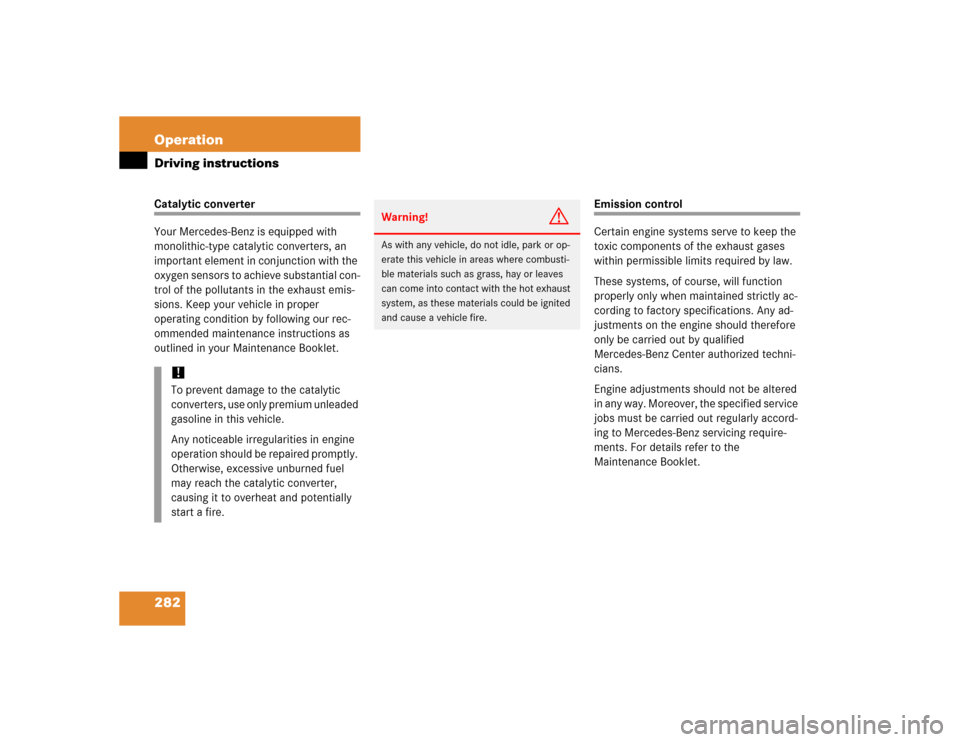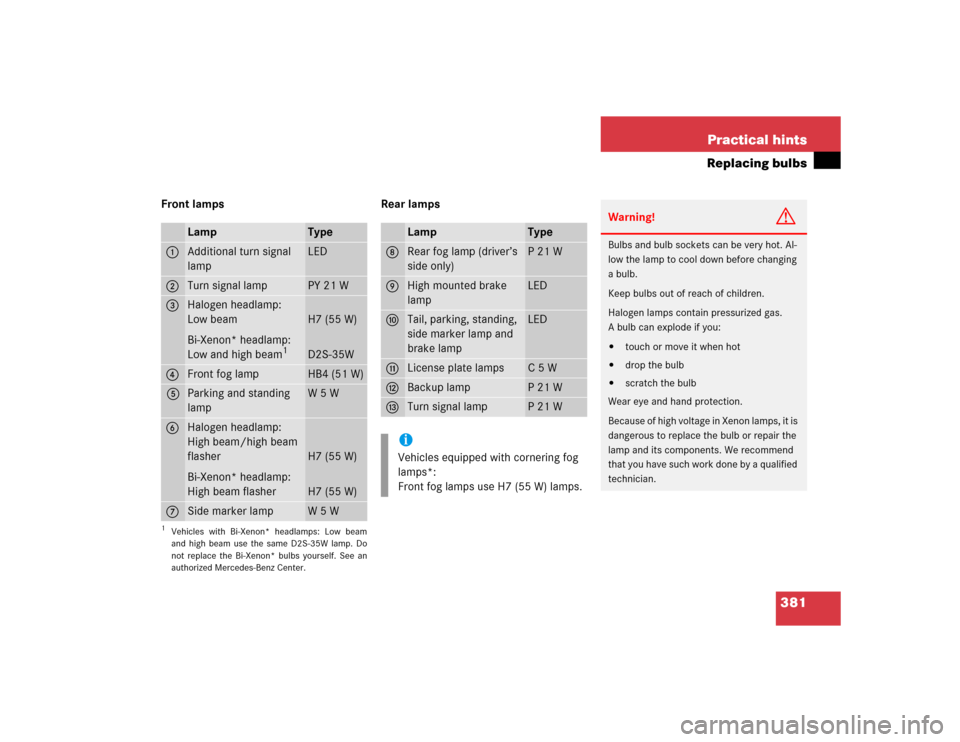Page 282 of 464

282 OperationDriving instructionsCatalytic converter
Your Mercedes-Benz is equipped with
monolithic-type catalytic converters, an
important element in conjunction with the
oxygen sensors to achieve substantial con-
trol of the pollutants in the exhaust emis-
sions. Keep your vehicle in proper
operating condition by following our rec-
ommended maintenance instructions as
outlined in your Maintenance Booklet.
Emission control
Certain engine systems serve to keep the
toxic components of the exhaust gases
within permissible limits required by law.
These systems, of course, will function
properly only when maintained strictly ac-
cording to factory specifications. Any ad-
justments on the engine should therefore
only be carried out by qualified
Mercedes-Benz Center authorized techni-
cians.
Engine adjustments should not be altered
in any way. Moreover, the specified service
jobs must be carried out regularly accord-
ing to Mercedes-Benz servicing require-
ments. For details refer to the
Maintenance Booklet.
!To prevent damage to the catalytic
converters, use only premium unleaded
gasoline in this vehicle.
Any noticeable irregularities in engine
operation should be repaired promptly.
Otherwise, excessive unburned fuel
may reach the catalytic converter,
causing it to overheat and potentially
start a fire.
Warning!
G
As with any vehicle, do not idle, park or op-
erate this vehicle in areas where combusti-
ble materials such as grass, hay or leaves
can come into contact with the hot exhaust
system, as these materials could be ignited
and cause a vehicle fire.
Page 381 of 464

381 Practical hints
Replacing bulbs
Front lamps Rear lamps
Lamp
Type
1
Additional turn signal
lamp
LED
2
Turn signal lamp
PY 21 W
3
Halogen headlamp:
Low beam
Bi-Xenon* headlamp:
Low and high beam
1
1Vehicles with Bi-Xenon* headlamps: Low beam
and high beam use the same D2S-35W lamp. Do
not replace the Bi-Xenon* bulbs yourself. See an
authorized Mercedes-Benz Center.
H7 (55 W)
D2S-35W
4
Front fog lamp
HB4 (51 W)
5
Parking and standing
lamp
W5W
6
Halogen headlamp:
High beam/high beam
flasher
Bi-Xenon* headlamp:
High beam flasher
H7 (55 W)
H7 (55 W)
7
Side marker lamp
W5W
Lamp
Type
8
Rear fog lamp (driver’s
side only)
P21W
9
High mounted brake
lamp
LED
a
Tail, parking, standing,
side marker lamp and
brake lamp
LED
b
License plate lamps
C5W
c
Backup lamp
P21W
d
Turn signal lamp
P21W
iVehicles equipped with cornering fog
lamps*:
Front fog lamps use H7 (55 W) lamps.
Warning!
G
Bulbs and bulb sockets can be very hot. Al-
low the lamp to cool down before changing
a bulb.
Keep bulbs out of reach of children.
Halogen lamps contain pressurized gas.
A bulb can explode if you:�
touch or move it when hot
�
drop the bulb
�
scratch the bulb
Wear eye and hand protection.
Because of high voltage in Xenon lamps, it is
dangerous to replace the bulb or repair the
lamp and its components. We recommend
that you have such work done by a qualified
technician.
Page 436 of 464

436 Technical termsRoll bar
Occupant protection system which
consists of tubular steel sheathed in
plastic.
RON
(R
esearch O
ctane N
umber)
The Research Octane Number for gaso-
line as determined by a standardized
method. It is an indication of a gaso-
line’s ability to resist undesired detona-
tion (knocking). The average of both
the ->MON (Motor Octane Number)
and RON (Research Octane Number) is
posted at the pump, also known as
ANTI-KNOCK INDEX.Shift lock
When the vehicle with automatic trans-
mission is parked, this lock prevents
the gear selector lever from being inad-
vertently moved out of positionP with-
out the SmartKey turned and the brake
pedal depressed.
Sidewall
(
�page 324)
Speedshift
Steering wheel gearshift control for ve-
hicles with automatic transmission.
You can change the gears yourself with
the steering wheel gearshift buttons.
SRS
(Supplemental R
estraint S
ystem)
Seat belts, emergency tensioning
device and air bags. Though indepen-
dent systems, they are closely inter-
faced to provide effective occupant
protection.Tele Aid system
(T
elematic A
larm I
dentification on
D
emand)
The Tele Aid system consists of three
types of response: automatic and man-
ual emergency, Roadside Assistance
and information. Tele Aid is initially ac-
tivated by completing a subscriber
agreement and placing an acquain-
tance call.
The Tele Aid system is operational pro-
vided that the vehicle’s battery is
charged, properly connected, not dam-
aged and cellular and GPS coverage is
available.
Tightening torque
Force times lever arm (e.g. a lug
wrench) with which threaded fasteners
such as wheel bolts are tightened.